Office ergonomics is about setting up the workplace to suit you and not having to adopt your body to suit the workplace.
In this video you will learn from Michael Terry of Momentum Safety about ergonomics for your office.
You will learn actions you can take to prevent injuries from awkward postures and repetitive activities.
Video Transcription
Let's talk about office ergonomics.
What we're really talking about here is trying to set up our workplace to suit us. Therefore not having to adapt our body to suit our workplace.
It's about creating an environment where it's set up to suit you, not the other way around.
It's really about setting up our desk environment so that it fits our natural postures, and we're not having to adapt ourselves into any awkward situations.
Key Risk Factors
If we look at our typical risk factors, they are: force and exertion, awkward postures, and repetition/duration.
Force is not going to be a big factor for the office workstation. You're not doing too much heavy lifting or movement.
But there could be some awkward postures, and there could be (or there certainly should be) some repetition and potentially a prolonged duration.
Awkward Postures
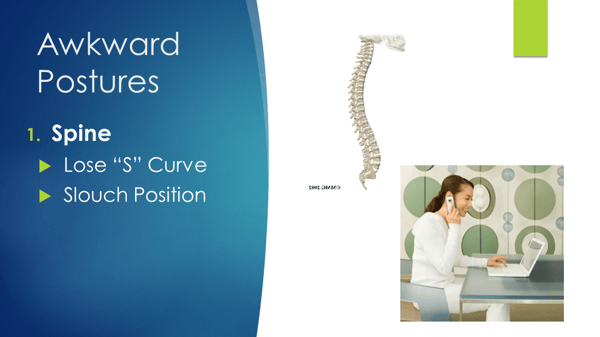
Here's a picture of someone starting to lose their posture. It doesn't look too bad if you look at the position there. She's only a little bit flexed, a little bit slouched. But, done over 8 hours a day, 5 days a week, for 4 months, that could start to add up.
So, these are the things where small differences done for a long period of time actually can make a really big difference.
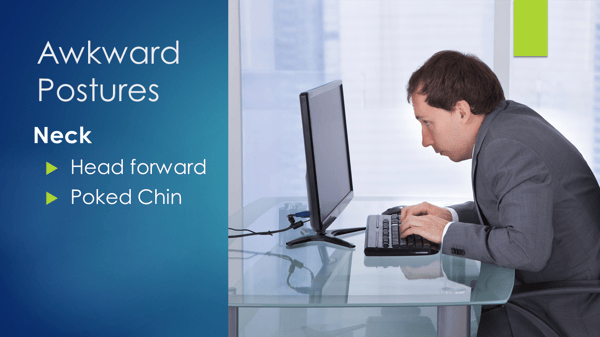
Here's another awkward posture. It looks like his screens a bit too low, his chin's poked forward, his head's bent forward. That will be placing undue stress on his neck, potentially creating neck pain, and possible headaches as well.
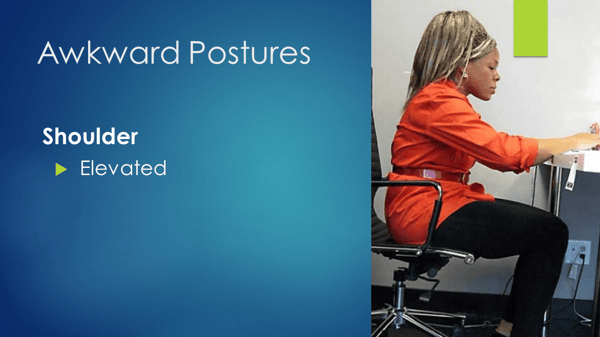
Here's another person who's got their chair too low, or their desk too high. It's causing their shoulder to be sort-of elevated up into the air. That's going to put much more stress on the shoulder and neck area, and potentially create problems with that.
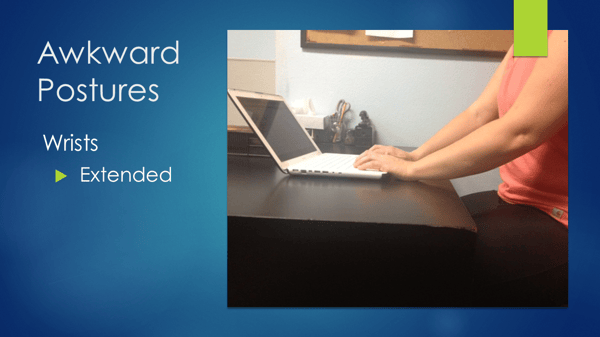
Here's a wrist one here. This person's got their chair too high this time, or desk too low. It's creating this extended wrist posture, which puts much more pressure on your forearms. So, these are some examples of postures which if you've done for prolonged periods, will add up to being aches and pains.
Repetition

Some of the things that we see from excessive repetition, or really prolonged duration, is a syndrome called Carpal Tunnel. This is excessive over-use of the wrist and hand, leading towards swelling in the wrist and numbness in the hand.
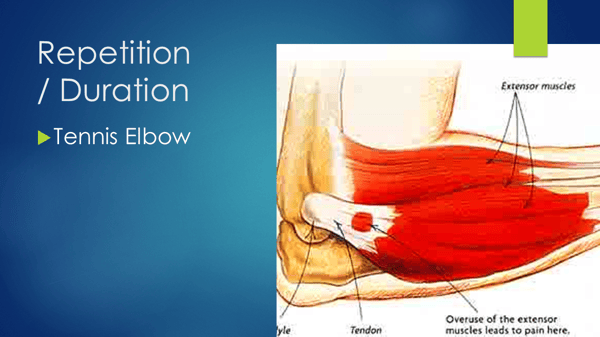
Some people also get what we call tennis elbow and this can be caused by poor wrist and prolonged wrist position and prolonged duration. It's a pain on the outside of the elbow, just near the bone.
Risk Control
So what follows from that, if we want to control our risk a little bit better, we need to do a few things.
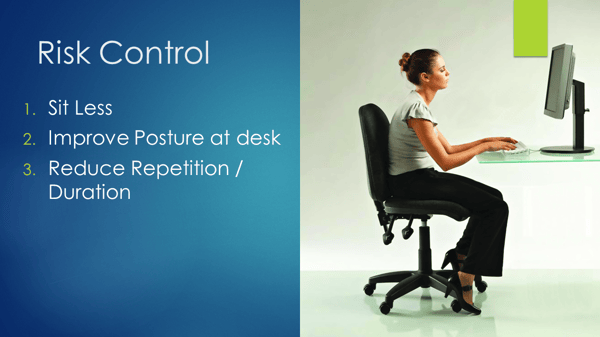
Sit Less
Firstly, we need to sit less, cause that's one of the most prolonged duration type things that we do in an office environment.
We need to improve our posture at the desk, and we need to somehow reduce the amount of repetition, or possibly some duration as well.
So let's look at how we might do that.
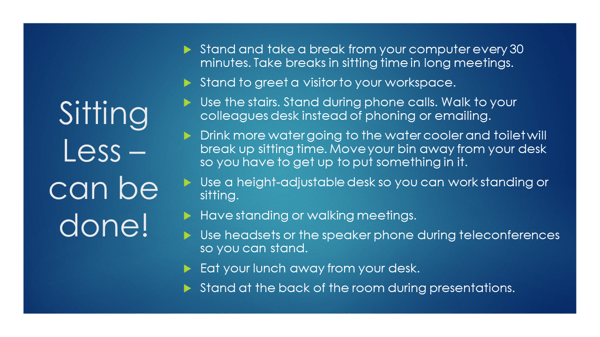
Sitting less is one of the big challenges of every office environment, and most people say "it can't be done, can't sit less" but there is some things that you can do. You've just got to try to incorporate a little bit of standing into your day.
- So try and take a break, usually every 30 minutes or so, just stand up if you can.
- If you've got meetings, try and stand up in your meetings.
- Stand to greet people.
- Stand to take phone calls.
- Drink lots of water. You'll have to go to the water cooler, but also that water's also got to go somewhere, so it's not a bad way to get yourself up and out of your chair.
- Try and get out and take a bit of a walk or at least stand for a period of time during your breaks just to try and break up that posture as much as you can.
- You don't have to do all of these things, but if you could start to do some of these things, it would definitely mean you are spending less time in your chair.
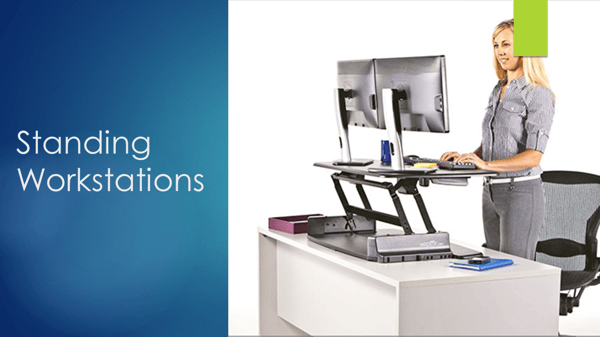
- Standing work stations are not a bad option, and they are becoming much more used these days. When they first came out I saw that they were very rare, and it was only the occasional person that had a standing workstation. Nowadays, they are much more popular. I still don't think they're for everyone, some people really love them, some people really don't. But they're not a bad option to get you out of the chair a little bit more.
Reduce Repetition
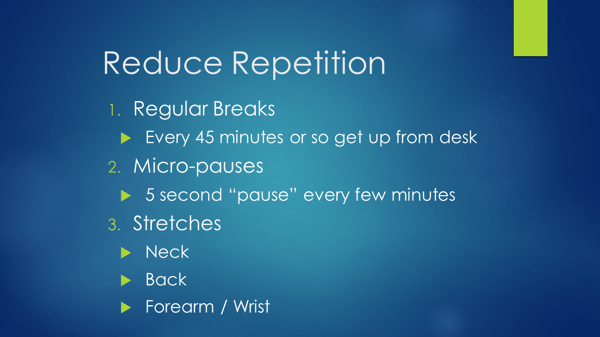
If we want to reduce our repetition, we should try and get in the habit of taking breaks every so often. 30-45 minutes is usually a good time. Get up and out of that desk.
If you're a very constant user of a keyboard or mouse, you should take what we call a micro-pause, every few minutes, just a 5 second break, where you flex and stretch muscles of your wrist and hand.
And also, just doing a few stretches is not a bad idea as well.

Things like some of these stretches here, so some side neck stretches, one we call neck retraction, which is making a double chi. You have to wait till people aren't looking at you before you do that one.
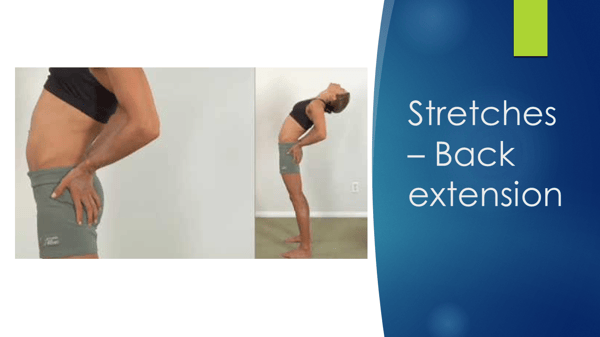
Back extensions are a great idea, that will definitely take away some of those flexed back postures that we talk about.
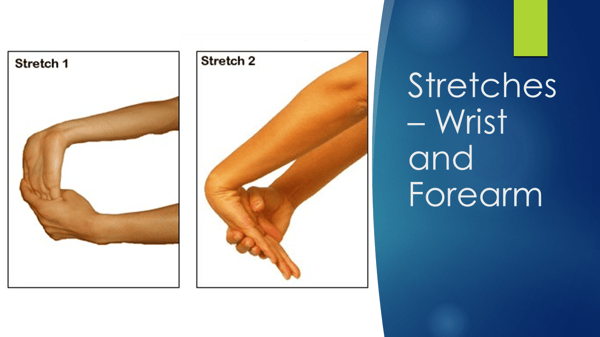
And also, there's a few wrist and forearm stretches which again, aren't a bad idea as far as just keeping those muscles nice and stretched, blood pumping through them.
Takeaways
- Set the workstation up to suit you, not the other way around.
- The typical risk factors are: force and exertion, awkward postures, and repetition/duration.
- For an office situation, awkward postures and repetition are the most common.
- To control the risks you should:
- Sit less
- Reduce repetition.
- You should take regular breaks, have micro pauses and stretch regularly.



